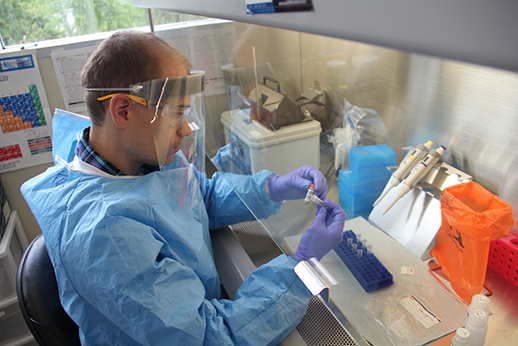Zika testing begins in the Hygienic Lab
 On Dec. 28, The New York Times first reported an outbreak of the Zika virus in Brazil and its seeming connection to microcephaly in babies. The Centers for Disease Control began issuing warnings shortly thereafter, and, as of May 25, reported 591 travel-related cases in the United States. No locally acquired vector-borne cases have been reported in the U.S.
On Dec. 28, The New York Times first reported an outbreak of the Zika virus in Brazil and its seeming connection to microcephaly in babies. The Centers for Disease Control began issuing warnings shortly thereafter, and, as of May 25, reported 591 travel-related cases in the United States. No locally acquired vector-borne cases have been reported in the U.S.
Zika is transmitted primarily by Aedes aegypti mosquitos and possibly by Aedes albopictus. Geographical threats currently range from Zika’s tropical and subtropical origins into North and South America. In addition to transmission from mother to fetus, the CDC reports Zika can be transmitted by males to their sexual partners.
Within weeks of the first public announcement of the outbreak, the State Hygienic Laboratory and the Iowa Department of Public Health (IDPH) were preparing for the worst.
Kris Eveland, clinical lab technical specialist in the Disease Control Division, was designated as coordinator of the Hygienic Lab’s Zika laboratory efforts. Specimens were approved for testing on a case by case basis by state epidemiologists at IDPH and then sent to the laboratory and prepped for shipment to CDC, the first lab in the country to perform the Zika testing.
Eveland worked with IDPH to determine which specimens would be processed by the laboratory before shipping them to CDC. His work also included sample receiving and logging and reporting CDC’s results to local clinics and state epidemiologists. He also created a database that recorded all approved testing, specimens received and epidemiological data not maintained in the lab’s information system.
Lab staff were aware of the possible magnitude of the outbreak from the beginning. “It became clear as early as February that the CDC would be putting forth their tests to the U.S. Food and Drug Administration (FDA) for EUA (Emergency Use Authorization),” Eveland said. An EUA allows the use of unapproved tests in a public health emergency.
“For a while though, it was just a waiting game to see what test(s) would be issued as an EUA and what they would involve,” Eveland said. “We had to get all the materials in-house for testing, and then pass a proficiency panel that was provided by the CDC for each of the two types of tests we’re doing.”
On April 27, the Hygienic Laboratory began Zika testing for all suspected cases in Iowa using the Trioplex Real-time RT-PCR assay and the Zika MAC-ELISA assay. The trioplex assay detects the presence of nucleic acid from three different Flaviviruses (Zika virus, Dengue virus, and Chikungunya virus) because individuals infected by any of these viruses can have similar symptoms.
The Zika MAC-ELISA assay detects the presence of Zika antibodies in a patient’s serum. If a patient has a positive Zika MAC-ELISA result, additional confirmatory testing must be performed by the CDC. Eveland follows the EUA testing algorithm to determine which tests will be performed on specimens received at SHL.
As of May 19, the laboratory has processed and/or tested nearly 200 specimens. At this time, we have six confirmed Zika virus positives, one presumptive positive pending confirmation and 161 negatives. Additionally, we have two Dengue virus positives, but no Chikungunya positives. All identified cases have been associated with travel to countries or territories reporting active mosquito transmission of Zika virus.
Public health laboratory work often is a collaborative process with internal staff and external partners, as it is in Zika response.
“It has been a true group effort,” Eveland says, “with lots of people chipping in to make this process go smoothly.”



